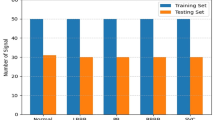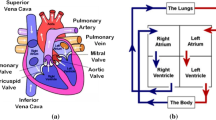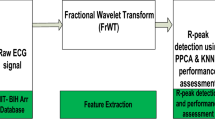Abstract
Motivation
Cardiologists rely on the long duration Holter electrocardiogram (ECG) recordings in general for assessment of abnormal episodes and such process found to be tedious and time consuming. An automatic abnormal cardiac episode detection algorithm is the need of the hour that needs to be optimized to reduce the manual burden.
Objective
The current study presents a signal processing framework with a cross-database to detect abnormal episodes in long-term ECG signals.
Methodology
The data was pre-processed to remove power line interference and baseline drift using basis pursuit sparsely decomposed tunable-Q wavelet transform (BPSD-TQWT). A total of 44 features of time domain, frequency domain, and time–frequency domain characteristics were extracted from the ECG signal. This proposed work tested classification performance with support vector machine (SVM), K-nearest neighbour (KNN), decision tree, naïve Bayes, the nearest mean classifier, and the nearest root mean square classifiers. The trained models with open-source data were used to predict the abnormal episodes from the proprietary database and vice versa. Finally, the performance was analysed via recall rate, specificity, precision, F1-score, and accuracy.
Results
Among six classification models, SVM performed best. With an open-source database, the SVM model achieved 95.01% accuracy, and detected the abnormal episodes from proprietary database with an accuracy of 99.31%. In addition, with the proprietary database SVM model classified the normal-abnormal cardiac episodes with an accuracy of 99.89% and detected the abnormal episodes from proprietary database with an accuracy of 92.51%.
Conclusion
When the performance results were compared with the literature, it was observed that the proposed framework performed well. As a result, the proposed framework could be used in an autonomous diagnosis system.



















Similar content being viewed by others
References
Alan, J., and N. Bogunovic. Random forest-based classification of heart rate variability signals by using combinations of linear and nonlinear features. XII Mediterranean Conference on Medical and Biological Engineering and Computing 2010. Berlin: Springer, 2010.
Arif, M., I.A. Malagore, and F.A. Afsar. Automatic detection and localization of myocardial infarction using back propagation neural networks. 4th International Conference on Bioinformatics and Biomedical Engineering (iCBBE), 2010, pp. 1–4.
Avvaru, S., N. Sriraam, V. S. Prakash, et al. Wearable Ag-NyW textile electrode for continuous ECG monitoring. Res. Biomed. Eng. 37:231–247, 2021. https://doi.org/10.1007/s42600-021-00147-2.
Aydın, S., S. Demirtaş, M. A. Tunga, et al. Comparison of hemispheric asymmetry measurements for emotional recordings from controls. Neural Comput. Appl. 30:1341–1351, 2018. https://doi.org/10.1007/s00521-017-3006-8.
Aydın, S., Ç. Güdücü, F. Kutluk, A. Öniz, and M. Özgören. The impact of musical experience on neural sound encoding performance. Neurosci. Lett. 694:124–128, 2019.
Bhaskar, N. Performance analysis of support vector machine and neural networks in detection of myocardial infarction. Procedia Comput. Sci. 46:20–30, 2015.
Bortolan, G., and W. Pedrycz. Hyperbox classifiers for arrhythmia classification. Kybernetes. 36(34):531–547, 2007.
Breiman, L. Classification and Regression Trees. The Wadsworth and Brooks–Cole Statistics Probability Series. Boca Raton: Chapman & Hall, 1984.
Cardoso-Fernandes, J., A. C. Teodoro, A. Lima, and E. Roda-Robles. Semi-automatization of support vector machines to map lithium (Li) bearing pegmatites. Remote Sens. 12(14):2319, 2020.
Carey, M.G. Cardiac Arrhythmias, An Issue of Critical Care Nursing Clinics of North America, E-Book, vol. 28, No. 3. St. Louis: Elsevier Health Sciences, 2016.
Chen, S.-W., P. Clarkson, and Q. Fan. A robust sequential detection algorithm for cardiac arrhythmia classification. IEEE Trans. Biomed. Eng. 43(11):1120–1124, 1996.
Christov, I., and G. Bortolan. Ranking of pattern recognition parameters for premature ventricular contractions classification by neural networks. Physiol. Meas. 25(5):1281–1290, 2004.
Goldberger, A. L., L. A. N. Amaral, L. Glass, J. M. Hausdorff, P. C. Ivanov, R. G. Mark, J. E. Mietus, G. B. Moody, C.-K. Peng, and H. E. Stanley. PhysioBank, PhysioToolkit, and PhysioNet: components of a new research resource for complex physiologic signals. Circulation. 101(23):e215–e220, 2000.
Gradl, S., et al. Real-time ECG monitoring and arrhythmia detection using Android-based mobile devices. Engineering in Medicine and Biology Society (EMBC), 2012 Annual International Conference of the IEEE. IEEE, 2012.
Harkat, A., R. Benzid, and L. Saidi. Features extraction and classification of ECG beats using CWT combined to RBF neural network optimized by cuckoo search via levy flight. In 2015 4th International Conference on Electrical Engineering (ICEE), 2015, pp. 1–4.
Heidarnejad, A., S. Setarehdan, and V. Nafisi. Detection of myocardial infarction using high-frequency QRS components. 2011 19th Iranian Conference on Electrical Engineering, 2011, pp. 1–5.
Jenkins, D., and S.J. Gerred. ECGs by Example E-Book. Elsevier Health Sciences, St. Louis, 2011.
Katritsis, D.G., A.J. Camm, and B.J. Gersh. Clinical Cardiology: Current Practice Guidelines. Oxford University Press, Oxford, p. 538. Archived from the original on 2016–10–02, 2016.
Kaveh, A., and W. Chung. Automated classification of coronary atherosclerosis using single lead ECG. Wireless Sensor (ICWISE) 2013 IEEE Conference on Kuching, 2013, pp. 108–113.
Keshtkar, A., H. Seyedarabi, P. Sheikhzadeh, and S. H. Rasta. Discriminant analysis between myocardial infarction patients and healthy subjects using wavelet transformed signal averaged electrocardiogram and probabilistic neural network. J. Med. Signals Sensors. 3(4):225–230, 2013.
Khazaee, A. Heartbeat classification using particle swarm optimization. Int. J. Intell. Syst. Appl. 5(6):25, 2013.
Kılıç, B., and S. Aydın. Classification of contrasting discrete emotional states indicated by EEG based graph theoretical network measures. Neuroinformatics. 2022. https://doi.org/10.1007/s12021-022-09579-2.
Kumar, R.G., and Y.S. Kumaraswamy. Investigation and classification of ECG beat using input output additional weighted feed forward neural network. International Conference on Signal Processing Image Processing & Pattern Recognition (ICSIPR), 2013, pp. 200–205.
Leutheuser, H., et al. Automatic ECG arrhythmia detection in real-time on android-based mobile devices. Proceedings of the MobileMed 2014 Conference, Prague, Czech Republic, 21 November 2014.
Moody, G. B., and R. G. Mark. The impact of the MIT-BIH arrhythmia database. IEEE Eng. Med. Biol. 20(3):45–50, 2001.
Mozaffarian, D., et al. “Heart disease and stroke statistics—2016 update: a report from the American Heart Association”, on behalf of the American Heart Association Statistics Committee and Stroke Statistics Subcommittee. Circulation. 2015. https://doi.org/10.1161/CIR.0000000000000350.
Padmavathi, S., and E. Ramanujam. Naïve Bayes classifier for ECG abnormalities using multivariate maximal time series. Motif Procedia Comput. Sci. 47:222–228, 2015. https://doi.org/10.1016/j.procs.2015.03.201.
Pan, J., and W. J. Tompkins. A real-time QRS detection algorithm. IEEE Trans. Biomed. Eng. 1985. https://doi.org/10.1109/TBME.1985.325532.
Raghu, S., et al. Automated detection of epileptic seizures using successive decomposition index and support vector machine classifier in long-term EEG. Neural Comput. Appl. 32(13):8965–8984, 2020.
Sahu, N. K., S. Ayub, and J. P. Saini. Detection of normal ECG and arrhythmia using adaptive neuro-fuzzy interface system. Int. J. 3:11, 2013.
Said Ahmad, A. S., et al. Feature optimization for ECG signals classification. Int. J. Adv. Comput. Sci. Appl. 9(11):383–389, 2018.
Šapina, M., M. Garcin, K. Kramarić, K. Milas, D. Brdarić, and M. Pirić. The Hurst exponent of heart rate variability in neonatal stress, based on a mean reverting fractional Lévy stable motion. Fluct. Noise Lett. 19(03):2050026, 2020.
Srinivasulu, A., and N. Sriraam. Basis pursuit sparse decomposition using tunable-Q wavelet transform (BPSD-TQWT) for denoising of electrocardiograms. Phys. Eng. Sci. Med. 2022. https://doi.org/10.1007/s13246-022-01148-w.
Veenman, C. J., and M. J. Reinders. The nearest subclass classifier: a compromise between the nearest mean and nearest neighbour classifier. IEEE Trans. Pattern Anal. Mach. Intell. 27(9):1417–1429, 2005.
Wade, G. Book Review: Tachycardias: Mechanisms, Diagnosis, Treatment. London: Wolfe Medical, 1985.
Whitaker, B. M., et al. AF classification from ECG recording using feature ensemble and sparse coding. Comput. Cardiol. 44:1–4, 2017.
Yeh, S.T. Using trapezoidal rule for the area under a curve calculation. Proceedings of the 27th Annual SAS® User Group International (SUGI’02), 2002.
Yu, X., Z. Mei, C. Chen, and W. Chen. Ranking power spectra: a proof of concept. Entropy. 21:1057, 2019. https://doi.org/10.3390/e21111057.
Acknowledgments
The authors would acknowledge the Department of Bio-Technology (DBT) funding for carrying out this research work (BT/PR14751/MED/32/422/2015).
Author information
Authors and Affiliations
Corresponding author
Additional information
Associate Editor Christian Zemlin oversaw the review of this article.
Publisher's Note
Springer Nature remains neutral with regard to jurisdictional claims in published maps and institutional affiliations.
Rights and permissions
Springer Nature or its licensor (e.g. a society or other partner) holds exclusive rights to this article under a publishing agreement with the author(s) or other rightsholder(s); author self-archiving of the accepted manuscript version of this article is solely governed by the terms of such publishing agreement and applicable law.
About this article
Cite this article
Srinivasulu, A., Sriraam, N. & Prakash, V.S. A Signal Processing Framework for the Detection of Abnormal Cardiac Episodes. Cardiovasc Eng Tech 14, 331–349 (2023). https://doi.org/10.1007/s13239-023-00656-4
Received:
Accepted:
Published:
Issue Date:
DOI: https://doi.org/10.1007/s13239-023-00656-4




